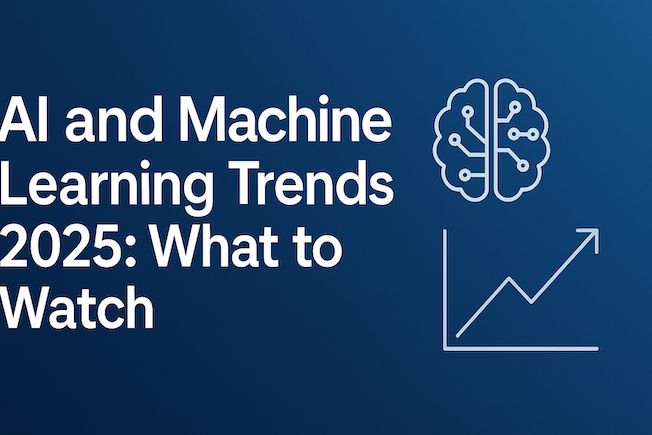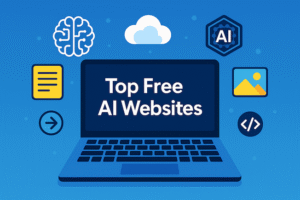Why AI and Machine Learning Trends Matter Now?
AI and machine learning trends 2025 aren’t just buzzwords—they’re shaping how we build products, scale infrastructure, and protect data. From multimodal foundation models to on-device inference and stricter governance, here are the developments that matter in 2025—and the exact steps to get ready.
1) Multimodal AI Becomes Default
Text, image, audio, and video models converge. Expect search, customer support, analytics, and creative tools to operate across formats out-of-the-box.
What to do:
- Store embeddings for multiple modalities (text+image/video).
- Standardize on a vector database and embed pipelines early.
- Add image/OCR + audio (ASR/TTS) to your existing text flows.
2) Smaller, Cheaper, Task-Tuned Models (SLMs)
“Right-sized” small language models fine-tuned with domain data often beat huge general models on latency, cost, and accuracy.
Action plan:
- Benchmark SLMs vs LLMs on your tasks (latency, cost/1k tokens, accuracy).
- Distill or LoRA-tune a compact model on your internal corpus.
3) Retrieval-Augmented Generation 2.0 (RAG++ )
RAG evolves: better chunking, reranking, structured citation, and tool use.
Action plan:
- Move to hierarchical or semantic chunking + cross-encoder rerankers.
- Log unanswered questions → close content gaps.
- Return citations/IDs to build user trust and auditability.
4) AI Agents and Workflow Automation
Agents orchestrate tools (databases, CRMs, code exec) to complete multi-step tasks. The winning setups are narrow, supervised, and reliably measurable.
Action plan:
- Start with narrow SOPs: define tools, guardrails, SLAs.
- Track success rate, intervention rate, and cycle time.
5) On-Device & Edge Inference
Privacy, latency, and cost push inference to mobile/edge. Quantization + optimized runtimes make it practical.
Action plan:
- Quantize (8-bit/4-bit) and test accuracy deltas.
- Cache prompts/results; fall back to cloud for heavy cases.
6) Safety, Governance, and Audits Go Mainstream
New regulations require model cards, data lineage, evals, and incident response.
Action plan:
- Maintain a model registry (owner, training data, evals, version).
- Run pre-deployment red-team + ongoing bias/safety evals.
- Add PII scanning and deletion workflows to your data lake.
7) Synthetic Data (with Guardrails)
Teams fill rare edge cases (class imbalance, privacy-sensitive data) using synthetic datasets—validated with robust evals to avoid model drift.
Action plan:
- Generate → filter → mix with real data; measure uplift vs baseline.
- Monitor for overfitting to synthetic artifacts.
8) Privacy-Preserving ML
Federated learning, secure enclaves, and differential privacy land in production for regulated industries.
Action plan:
- Hash & tokenize sensitive fields; apply DP where needed.
- Explore TEEs/SMPC for cross-org collaboration.
9) LLMOps: From Demos to Reliable Systems
Prompt/version control, offline evals, guardrails, canary deploys, and live monitoring become mandatory.
Action plan:
- Treat prompts like code (version, review, test).
- Build an evaluation harness with golden sets and real user traffic.
- Monitor toxicity, hallucination rate, latency, cost, CTR, CSAT.
10) Cost & Carbon Optimization
Token budgets, caching, quantization, batching, and green scheduling reduce spend and footprint.
Action plan:
- Cache embeddings + responses aggressively.
- Choose lowest-cost model that meets your SLA; batch background jobs.
Tech Stack Blueprint (Opinionated)
- Ingestion & Storage: object storage + data lakehouse, row-level lineage
- Vector: production-grade vector DB (HNSW/IVF) + hybrid search (BM25+ranks)
- Serving: gateway that can route to SLM/LLM, supports tools & function calling
- Observability: tracing (prompt→tool→response), eval service, cost dashboards
- Governance: model registry, policy engine (PII, role-based access), audit logs
Metrics That Matter
- Answer quality: win-rate vs human baseline, groundedness, citation coverage
- Operational: latency p95, cost per session, cache hit-rate, failure/intervention rate
- Business: conversion lift, time-to-resolution, deflection rate, NPS/CSAT
Common Pitfalls (and Fixes)
- One-model-fits-all: Route by task; keep SLMs for cheap, fast wins.
- No evals: Build golden sets early; automate regression checks.
- Unstructured knowledge: Poor chunking kills RAG—invest in preprocessors.
- Shadow AI: Centralize access; add key management and policy controls.
Quick Start Checklist
- Define your focus use cases (search, support, analytics, coding).
- Build a RAG baseline with citations and reranking.
- Add a small tuned model for your top task; compare to LLM.
- Ship a narrow agent with clear SOPs + metrics.
- Stand up LLMOps: evals, tracing, safety, cost dashboards.
FAQ
Q1: Will AI replace developers in 2025?
No—developers who use AI will replace those who don’t. The edge is workflow design, evaluation, and domain context.
Q2: Should we fine-tune or use RAG?
Start with strong RAG (cheaper, auditable). Fine-tune when you see repetitive gaps or style constraints.
Q3: How do we control hallucinations?
Ground every answer with retrieval, require citations, and use constrained generation (tools, schemas).





